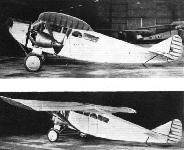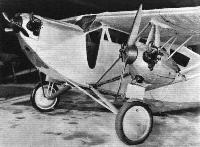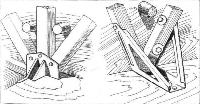
Flight, March 1931
THE NAVARRO "CHIEF"
A Low-Power Three-Engined Monoplane Three Seater
WHAT is probably the smallest three-engined aeroplane in the world has just been completed at Heston by Navarro Safety Aircraft, Limited. Known as the Navarro "Chief," the new machine is a three-seater fitted with three A.B.C. "Scorpion" engines. In addition, the aerodynamic design is unusual in that it incorporates a number of features which the designer, Mr. J. G. Navarro, believes will make the new machine immune from most of the evils to which aircraft are subjected, such as stalling, spinning and sideslipping. Whether all these claims will be realised, remains to be seen. At any rate, Mr. Navarro has made a determined attempt to "go one better," and has not remained content to follow the beaten track.
The aerodynamic features by which Mr. Navarro hopes to avoid stalling, spinning and sideslipping may possibly be seen most readily in the general arrangement drawings on the next page. To take spinning first, it will be noted that the elevator flaps are hinged along axes which make an angle with the transverse axis of the machine. Mr. Navarro's theory is that, in a manoeuvre like the spin, the air would be striking one elevator flap practically "edge on," and the other at a large angles, and that this would prevent the machine from continuing the spin. It is a little difficult to see the theoretical justification for Mr. Navarro's claim, but as the machine will be flying shortly, the proof of the pudding should soon be available.
The non-sideslip characteristics of the machine Mr. Navarro hopes to attain by the use of up-tilted wing tips. These, it will be recalled, are used on the fixed wings of the latest "Autogiro" machines, and so are less experimental in character than the diagonally-hinged elevator flaps. The non-stalling qualities of the machine Mr. Navarro hopes to obtain mainly by the plan form of his wing, in conjunction with an elevator of somewhat unusual section.
Finally, an air brake is fitted in the Navarro "Chief" which, although not entirely original, has not been seen on an aircraft since the early days of flying. This takes the form of a "split" rudder, the two halves of which lie close together in normal flight, but open like a book when used as an air brake. A very similar principle was experimentally tried many years ago, on, if we are not mistaken, a Bleriot monoplane of the "Cross-Channel" type. What success, if any, attended this arrangement we do not recollect.
From what has been said, it will be clear that the Navarro "Chief" is not without unorthodox features, but even if all the designer's hopes are not realised, the machine should be none the worse off for the use of these unusual ideas, as the general behaviour can, presumably, be tried out without adding to the risk. For example, the "split" rudder need not be used until the machine has been otherwise tried, while the diagonal elevator hinge could hardly cause trouble, even should it fail to do what is expected of it in the matter of preventing spinning.
Regarded as an ordinary aeroplane, and leaving on one side all the experimental features introduced in the design, the Navarro "Chief" might form a serviceable type for certain kinds of work. The use of three engines must, of necessity, reduce the aerodynamic efficiency and so the "Chief" can scarcely be expected to be, for instance, as fast as a single-engined type of the same weight and power. But if the three-engined power plant arrangement results in a marked improvement in immunity from forced landings, the sacrifice of a few miles per hour might well be tolerated for certain classes of flying.
It would also seem that a three-engined machine, whatever its engines, must be more expensive to produce than a single-engined type of the same power and seating capacity. Maintenance is likely to be more expensive, as there are three engines to look after, with three separate engine installations. Thus one cannot help thinking that in this small size the application of the three-engined principle will not result in a machine called for in a general way. That is not to say that the type will not have its uses. In certain circumstances, the avoidance of forced landings may be absolutely imperative, and if the Navarro "Chief" proves to be able to maintain its height on any two engines, it may be worth its extra cost and maintenance.
Constructionally, the "Chief" is a straightforward aircraft in most respects, with a fuselage built of wood, with plywood planking, and wings having wooden spars and ribs and a fabric covering.
The fuselage is of the flat-sided type, with rounded corners. The forward part carries the mounting for the central engine, and behind that comes the cabin, with the three seats arranged one behind the other, the pilot occupying the front seat.
A windscreen in front, and windows in the sides of the cabin give light and view, the deck fairing in front of the forward seat being dropped to enable the pilot to look forward over the central engine.
The monoplane wing is of orthodox construction, in wood with fabric covering. The wing folding arrangement is rather clever. Had the hinge been placed on the rear spar, just behind the outboard engine, the folded width would have been increased by the wing chord on each side, and folding would hardly have been worth while. Mr. Navarro then devised the scheme of hinging the wing where the rear spar joins the fuselage, the wing structure being completed by a false rear spar over the inner length, so that when the wing is folded rigidity is maintained by the main rear spar, which runs through from root hinge to wing tip, and by the outer portion front spar, with the Vee wing-bracing struts. In this way the folded width of the machine is kept down to the actual width over engine mountings. The trailing edge inner portion folds upwards.
The three A.B.C. "Scorpion" engines are mounted one in the nose and the other two outboard under the wing. Petrol is carried in the short wing roots which remain in place when the wing is folded, and this location of the tanks gives direct gravity feed to all three engines. The two wing engines are enclosed in streamline cowls, and the central engine is also cowled in except for its cylinder heads.
The undercarriage is of the "split" type, with radius rods and bent axles hinged to the lower longerons of the fuselage, and the telescopic legs going to the wing engine mountings. The telescopic legs, by the way, are of the type used on the Avro 504, with one single and one double strut carrying cross heads over which the elastic is stretched. The wheels are ready for the fitting of brakes, but brakes have not actually been incorporated yet, some of the undercarriage fittings being barely strong enough to take the brake loads, and requiring to be modified before the brakes are actually used.
The Navarro "Chief" was designed for a tare weight of 1,050 lb., and a gross weight of 1,800 lb., but as so often happens the first machine has exceeded the calculated weight somewhat. Mr. Navarro is, however, confident that in the production machine the extra weight can be saved and the full estimated load carried.
It is expected that the "Chief" will make its test flights quite soon. Further particulars may be obtained from Navarro Safety Aircraft, Limited, Heston Air Park, Hounslow, Middlesex. The telephone number is Hayes 410, Extension 39.
- Flight, March 1931
THE NAVARRO "CHIEF"
Фотографии
-
Air Enthusiast 2007-09 / A.Ord-Hume - Catalogue of Failure /Paper planes - projects/
In 1929 Navarro unveiled his Navarro Safety Aircraft called the Chief
-
Flight 1931-03 / Flight
THE NAVARRO "CHIEF": Side and three-quarter rear views.
-
Flight 1931-03 / Flight
TWO OF THE THREE ENGINES: Note also the undercarriage with mudguards over the wheels. When the wing is folded the point of the fairing of the outboard engine moves back with the wing bracing strut.
-
Air Enthusiast 2007-09 / A.Ord-Hume - Catalogue of Failure /Paper planes - projects/
The curious split rudder air-brake and diagonally-hinged differential elevators are shown in this tail-end view of the Chief.
-
Flight 1931-03 / Flight
THE AIR BRAKE: The "split" rudder acts as an air brake. It is here shown in the closed and open positions.
-
Flight 1931-03 / Flight
THE WING FOLDING ARRANGEMENT OF THE NAVARRO "CHIEF": On the left a photograph of the port wing folded, and on the right a diagram of the folding scheme.
-
Flight 1931-03 / Flight
THE NAVARRO "CHIEF": Attachment of wing-bracing Vee struts to lower corner of fuselage.
-
Flight 1931-03 / Flight
TWO INTERNAL FUSELAGE DETAILS: On the left the internal fitting in way of lift strut attachment, and on the right a typical fuselage bracing bracket. The pillars projecting inwards from the fuselage walls are of cork, and are intended to deaden noise.
-
Air Enthusiast 2007-09 / A.Ord-Hume - Catalogue of Failure /Paper planes - projects/
Three-view of the Navarro Chief
-
Flight 1931-03 / Flight
Navarro 3 Seater 3 A.B.C. "Scorpion" Engines
- Фотографии










